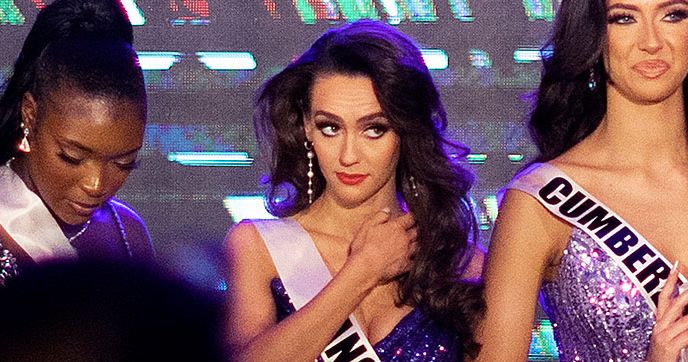Culture
A guide to Christmas-themed trading cards: From Santa Claus to Clark Griswold

Sports stars, celebrities, and even cryptocurrency all have rookie cards… but does Santa Claus? It’s a question you may ask yourself after consuming a little too much nutmeg. And since the season of giving is officially here, I want to spread some holiday cheer by highlighting Christmas-themed trading cards, which is a bigger niche than you may realize.
So let’s dive into a fun corner of the trading card world, one dominated by the GOAT of gift giving himself: Old St. Nick.
A brief history of Santa Claus trading cards
An 1891 Woolson Spice card. (Photo: eBay)
There isn’t a concrete origin story of Santa Claus trading cards, but some of the first examples in the United States date back to the late 1800s. Ohio-based company Woolson Spice created several artistic Christmas trading cards featuring Santa sitting around the tree with children or on his sleigh. Woolson Spice used the back of the cards to advertise its products, such as Lion Coffee.
There technically isn’t a card from the 19th century that’s coined as Santa’s “true” rookie card among the collecting community, but one of his most known from the time can be found in the 1890 Duke Holidays set. The popular tobacco company produced a 50-card set featuring three Christmas cards, but only the U.S. variation included Santa Claus. According to Professional Sports Authenticators’ (PSA) graded population report, the company has authenticated less than 15 copies. An example of the card is even in the Metropolitan Museum of Art’s collection.

1890 Duke Holidays Christmas, U.S. card. (Photo: Metropolitan Museum of Art)
It’s fascinating to see Santa Claus’ evolution from how he was depicted back then compared to today. Many early picture cards showed a thinner-looking version, sometimes dressed in a green or brown suit. It was Coca-Cola’s advertisements starting in the early 1930s that cemented the image of Santa Claus that we have today (although it was political cartoonist Thomas Nast who originated it in the 1860s). And yes, there are trading cards featuring those old Coke ads that were made in the 1990s.
In the late 1980s, the sports card industry exploded in popularity and began producing more and more sets. One of the first Santa Claus cards that caught the attention of modern collectors is the iconic 1989 Pro Set Football card. The promotional card was given to card shop owners and dealers during the holidays and could not be pulled out of packs, which heightened demand for it.

1989 Pro Set promo card. (Photo: eBay)
The front of the card lists Santa Claus as a “player-coach” and depicts him wearing a baseball cap bearing his own name and a red satin jacket emblazoned with the NFL logo. Inexplicably, he is holding up the very same trading card that he is on, creating a mind-bending card-ception loop. Behind Santa Claus, through a snow-covered window are two Pro Set executives dressed as elves (Leaf remade this card in 2021 with a selection of notable figures ranging from Donald Trump to Pele there instead, which can complicate searches for the more valuable original). The back of the card features Santa Claus’ vital info and a scouting report.
It was such a hit that Pro Set began putting Santa Claus cards into its sets starting in 1990. All of those were printed in far higher quantities, making them easy to obtain today, but the ‘89 card is still highly sought after, with “gem mint” PSA 10 graded copies selling for around $500 to $750.
As the sports card industry continued to innovate in the 1990s, it opened up new opportunities to celebrate the holidays through autograph and memorabilia cards. One of the first autographed cards of Santa Claus can be found in 1991’s Pro Line Portraits with the rarest version limited to 200 copies.
In 1998, Upper Deck produced an oversized Kris Kringle promo card featuring a velvety red piece of “holiday-worn jersey” that was exclusive to the company’s Collector’s Club members. The card can be found on eBay for around $20.
In 2007, Topps created the most comprehensive offering yet, with a special Santa Claus Holiday Set that contains 18 cards, all featuring versions of Santa Claus on Topps’ most popular designs of all time, including a Kris Kringle relic card, an autograph card, and a rookie card that pays homage to Mickey Mantle’s famous 1952 Topps card. Instead of being a “Topps Certified Autograph,” the signed card in this set is a “Topps Santafied Autograph,” with the back of the card insisting, “Santa himself signed this card with the very pen he uses to make his list of all the naughty and nice children around the world.” The back of the relic card, bearing a piece of Santa’s suit, says, “Topps acquired this suit from Santa himself, who requested it be spread as far and as wide as possible so everyone could have a piece of his holiday spirit to cherish and revisit whenever they wish.”

2007 Topps Holiday Set. (Photo: eBay)
In recent years, Topps has produced more Santa Claus autograph and relic cards for its holiday baseball sets (more on those in a minute), but the disclosures have gotten decidedly less whimsical. “The relic on this card is not from anything at all,” says the back of a 2019 offering.
Over the last decade or so, the hobby’s annual holiday set releases have produced more Santa Claus trading cards than ever before. In the most recent Topps Holiday set releases, collectors can pull rare chase cards of other classic North Pole characters such as Mrs. Claus, Frosty the Snowman, the Gingerbread Man, and more.
Holiday-themed sports sets
The sports card industry offers a few holiday-themed sets that bring a seasonal vibe to collecting with unique player-worn holiday sweater cards and festive super short print variations.
The main baseball card release centered around this festive time of the year is Topps Holiday. First produced in 2016, the set has holiday-inspired designs of the MLB’s rookies and stars where you can find hidden elves, snowflakes, and Christmas lights on cards. Collectors can pull autograph cards, player-worn Christmas hat relics, and those aforementioned rare relic/auto cards of Santa Claus. Topps Holiday sets are retail exclusives that can be found online and in stores like Target and Walmart.

2024 Topps Holiday Bobby Witt, Jr. image variation. (Photo: eBay)
A few years after the first Topps Holiday release, Panini, which produces NFL and NBA licensed trading cards, began offering Hoops Basketball and Donruss Football holiday-themed sets that have also become popular with collectors. In 2022 Donruss Football, Panini released a visually stunning Santa Claus Downtown insert. The ultra-rare case hit (there has traditionally been only one Downtown insert per every couple hundred packs) is still in massive demand, with PSA 10 copies selling for more than $1,500. The one-of-a-kind Clearly Donruss Holo parallel of this card sold for $3,234.71 in June of this year — a record high for a Santa Claus card, according to CardLadder’s database, which tracks card sales across major online marketplaces.
I would consider these products to be more collector-focused, with less monetary value on average than many other sets, but they offer plenty of chase cards and autograph relics of top rookies and stars that can still fetch hundreds of dollars. PSA 10 Topps Holiday base rookie cards of superstars like Aaron Judge and Shohei Ohtani sell for north of $100.
Classic holiday movie trading cards

This Peter Billingsley autographed A Christmas Story card sold for $750. (Photo: eBay)
One of my favorite holiday traditions is to sit back with a glass of eggnog and watch Christmas movies — a genre that is also making its way into trading card forms now. This year, actor Chevy Chase released a Christmas Vacation 35th Anniversary Box Set that offers signed cards of the Griswold family and personally used Chevy Chase relic cards. The limited edition release of 300 boxes quickly sold out, but a few have made it to eBay.
Cryptozoic Entertainment and Marquee Trading Cards recently put out a similar set based on the beloved holiday movie “A Christmas Story” to celebrate the 40th anniversary of the film’s release. Collectors have the chance to pull single and dual autograph cards signed by the cast, hand-drawn sketch cards, and serial-numbered chase cards. Sealed boxes are available on eBay for around $130 and a 1/1 Peter Billingsley (Ralphie) autograph card inscribed “I want a Red Ryder!” has already been pulled from a pack and sold for a penny shy of $1,000.
Billingsley also signed cards for Leaf, some with an “Oh fudge” inscription that are being sold for $99 each — exactly what someone might say after their loved ones find out they spent $99 on a Ralphie autographed card.
The Athletic maintains full editorial independence in all our coverage. When you click or make purchases through our links, we may earn a commission.
(Top photo: Stephen Pond/Getty Images)

Culture
How Manga Megastar Junji Ito Makes Terrifying Series Like ‘Uzumaki’

The horror cartoonist Junji Ito, creator of popular series like “Tomie” and “Uzumaki,” is one of manga’s biggest stars in the United States. And even those who don’t know his name might find his art oddly familiar, because adaptations of his work have repeatedly crossed over into more mainstream culture — often entirely out of context.
Culture
Do You Know the English Novels That Inspired These Movies and TV Shows?

Welcome to Great Adaptations, the Book Review’s regular multiple-choice quiz about books that have gone on to find new life as movies, television shows, theatrical productions, video games and more. This week’s challenge is focused on popular books set in 18th- and 19th-century England that have been adapted for the screen. Just tap or click your answers to the five questions below. And scroll down after you finish the last question for links to the books and their filmed versions.
Culture
Book Review: ‘Hunger Like a Thirst,’ by Besha Rodell

HUNGER LIKE A THIRST: From Food Stamps to Fine Dining, a Restaurant Critic Finds Her Place at the Table, by Besha Rodell
Consider the food critic’s memoir. An author inevitably faces the threat of proportional imbalance: a glut of one (the tantalizing range of delicacies eaten) and want of the other (the nonprofessional life lived). And in this age of publicly documenting one’s every bite, it’s easier than ever to forget that to simply have dined, no matter how extravagantly, is not enough to make one interesting, or a story worth telling.
Fortunately, the life of Beshaleba River Puffin Rodell has been as unusual as her name. In fact, as she relays in the author’s note that opens “Hunger Like a Thirst,” a high school boyfriend believed she’d “made up her entire life story,” starting with her elaborate moniker.
Born in Australia on a farm called Narnia, she is the daughter of hippies. Her father, “a man of many lives and vocations,” was in his religious scholar phase, whence Beshaleba, an amalgamation of two Bible names, cometh.
Rodell’s mother returned to her native United States, with her children and new husband, when Besha was 14. Within the first 20-plus years of her life, she had bounced back and forth repeatedly between the two continents and, within the U.S., between multiple states. “‘I’m not from here’ is at the core of who I am,” she writes.
It’s also at the core of her work as a restaurant critic, and what, she convincingly argues, distinguishes her writing from that of many contemporaries. She has the distanced perspective of a foreigner, but also lacks the privilege of her counterparts, who are often male and frequently moneyed. “For better or for worse, this is the life that I have,” she writes. “The one in which a lady who can’t pay her utility bills can nonetheless go eat a big steak and drink martinis.” This, she believes, is her advantage: “Dining out was never something I took for granted.”
It started back in Narnia on the ninth birthday of her childhood best friend, who invited Rodell to tag along at a celebratory dinner at the town’s fanciest restaurant. Rodell was struck, not by the food, but by “the mesmerizing, intense luxury of it all.” From then on, despite or perhaps because of the financial stress that remains a constant in her life, she became committed to chasing that particular brand of enchantment, “the specific opulence of a very good restaurant. I never connected this longing to the goal of attaining wealth; in fact, it was the pantomiming that appealed.”
To become a writer who gets poorly compensated to dine at those very good restaurants required working multiple jobs, including, in her early days, at restaurants, while simultaneously taking on unpaid labor as an intern and attending classes.
Things didn’t get much easier once Rodell became a full-time critic and she achieved the milestones associated with industry success. She took over for Atlanta’s most-read restaurant reviewer, then for the Pulitzer-winning Jonathan Gold at L.A. Weekly. She was nominated for multiple James Beard Awards and won one for an article on the legacy of the 40-ounce bottle of malt liquor.
After moving back to Australia with her husband and son, she was hired to review restaurants for The New York Times’s Australia bureau, before becoming the global dining critic for both Food & Wine and Travel & Leisure. Juxtaposed against the jet-setting and meals taken at the world’s most rarefied restaurants is her “real” life, the one where she can barely make rent or afford groceries.
It turns out her outsider status has also left her well positioned to excavate the history of restaurant criticism and the role of those who have practiced it. She relays this with remarkable clarity and explains how it’s shaped her own work. (To illustrate how she’s put her own philosophy into practice, she includes examples of her writing.) It’s this analysis that renders Rodell’s book an essential read for anyone who’s interested in cultural criticism.
Packing all of the above into one book is a tall order, and if Rodell’s has a flaw, it’s in its structure. The moving parts can seem disjointed and, although the intention behind the structure is a meaningful one, the execution feels forced.
As she explains in her epilogue, she used the table of contents from Anthony Bourdain’s “Kitchen Confidential” as inspiration for her own. Titled “Tony,” the section is dedicated to him. But, however genuine the sentiment, to end on a man whose shadow looms so large detracts from her own story. (If anything, Rodell’s approach feels more aligned with the work of the Gen X feminist Liz Phair, whose lyric the book’s title borrows.)
It certainly shouldn’t deter anyone from reading it. Rodell’s memoir is a singular accomplishment. And if this publication were to hire her as a dining critic in New York, there would be no complaints from this reader.
HUNGER LIKE A THIRST: From Food Stamps to Fine Dining, a Restaurant Critic Finds Her Place at the Table | By Besha Rodell | Celadon | 272 pp. | $28.99
-

 Education1 week ago
Education1 week agoA Professor’s Final Gift to Her Students: Her Life Savings
-

 Politics1 week ago
Politics1 week agoPresident Trump takes on 'Big Pharma' by signing executive order to lower drug prices
-

 Education1 week ago
Education1 week agoHarvard Letter Points to ‘Common Ground’ With Trump Administration
-

 Culture1 week ago
Culture1 week agoBook Review: ‘Original Sin,’ by Jake Tapper and Alex Thompson
-

 Culture1 week ago
Culture1 week agoTest Yourself on Memorable Lines From Popular Novels
-

 News1 week ago
News1 week agoAs Harvard Battles Trump, Its President Will Take a 25% Pay Cut
-

 News1 week ago
News1 week agoWhy Trump Suddenly Declared Victory Over the Houthi Militia
-

 News1 week ago
News1 week agoAustin Welcomed Elon Musk. Now It’s Weird (in a New Way).



















